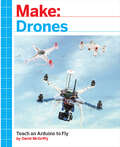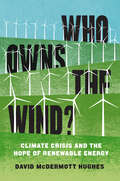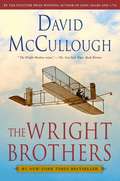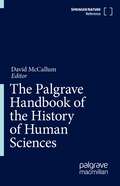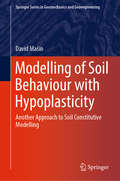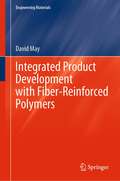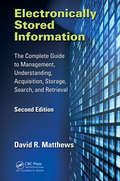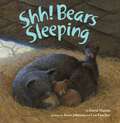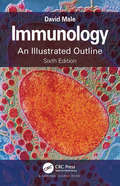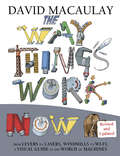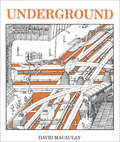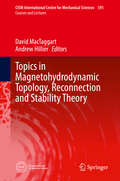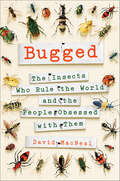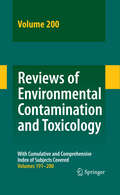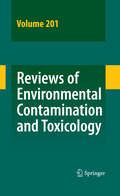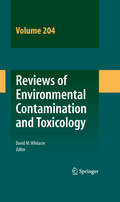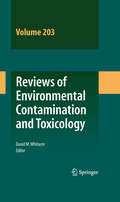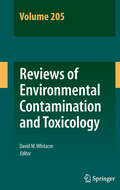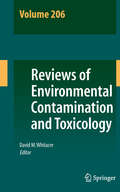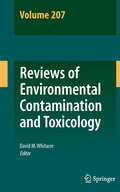- Table View
- List View
Make: Teach an Arduino to Fly
by David McGriffyMake: Drones will help the widest possible audience understand how drones work by providing several DIY drone projects based on the world's most popular robot controller--the Arduino. The information imparted in this book will show Makers how to build better drones and be better drone pilots, and incidentally it will have applications in almost any robotics project. Why Arduino? Makers know Arduinos and their accessories, they are widely available and inexpensive, and there is strong community support. Open source flight-control code is available for Arduino, and flying is the hook that makes it exciting, even magical, for so many people. Arduino is not only a powerful board in its own right, but it's used as the controller of most inexpensive 3d printers, many desktop CNCs, and the majority of open source drone platforms.
The Biological Bases of Economic Behaviour: A Concise Introduction
by David McFarlandHuman genetics has changed little over the past 20,000 years, but human economic behaviour has changed a lot. These changes are probably due to human cultural evolution. But studies of human hunter-gatherers, and of a variety of other animal species, show that their micro-economic behaviour is much the same. Whereas the standard economic analysis focuses on money, the biological approach brings time and energy into the analysis. Moreover, humans and other animals tested under laboratory conditions do not exhibit the complexity of the results of field studies. In other words, results obtained in the real world are not the same as those obtained in the laboratory. <P><P> The Biological Bases of Economic Behaviour invites readers to approach micro-economics from a biological viewpoint, in a clear and introductory manner.
Who Owns the Wind?: Climate Crisis and the Hope of Renewable Energy
by David McDermott HughesWhy the wind, and energy it produces, should not be private propertyThe energy transition has begun. To succeed—to replace fossil fuels with wind and solar power—that process must be fair. Otherwise, mounting pop- ular protest against wind farms will prolong carbon pollution and deepen the climate crisis. David McDermott Hughes examines that anti-industrial, anti- corporate resistance, drawing on his time spent conducting field research in a Spanish village surrounded by wind turbines. In the lives of a community freighted with centuries of exploitation—people whom the author comes to know intimately—clean power and social justice fit together only awkwardly. A green economy will require greater efforts to get ordinary people such as these on board. Aesthetics, livelihood, property, and, most essentially, the private nature of wind resources—all these topics must be examined with fresh eyes.
The Wright Brothers: The Dramatic Story-behind-the-story
by David McCulloughThe #1 New York Times bestseller from David McCullough, two-time winner of the Pulitzer Prize—the dramatic story-behind-the-story about the courageous brothers who taught the world how to fly—Wilbur and Orville Wright.On a winter day in 1903, in the Outer Banks of North Carolina, two brothers—bicycle mechanics from Dayton, Ohio—changed history. But it would take the world some time to believe that the age of flight had begun, with the first powered machine carrying a pilot. Orville and Wilbur Wright were men of exceptional courage and determination, and of far-ranging intellectual interests and ceaseless curiosity. When they worked together, no problem seemed to be insurmountable. Wilbur was unquestionably a genius. Orville had such mechanical ingenuity as few had ever seen. That they had no more than a public high school education and little money never stopped them in their mission to take to the air. Nothing did, not even the self-evident reality that every time they took off, they risked being killed. In this “enjoyable, fast-paced tale” (The Economist), master historian David McCullough “shows as never before how two Ohio boys from a remarkable family taught the world to fly” (The Washington Post) and “captures the marvel of what the Wrights accomplished” (The Wall Street Journal). He draws on the extensive Wright family papers to profile not only the brothers but their sister, Katharine, without whom things might well have gone differently for them. Essential reading, this is “a story of timeless importance, told with uncommon empathy and fluency…about what might be the most astonishing feat mankind has ever accomplished…The Wright Brothers soars” (The New York Times Book Review).
The Palgrave Handbook of the History of Human Sciences
by David McCallumThe Palgrave Handbook of the History of Human Sciences offers a uniquely comprehensive and global overview of the evolution of ideas, concepts and policies within the human sciences. Drawn from histories of the social and psychological sciences, anthropology, the history and philosophy of science, and the history of ideas, this collection analyses the health and welfare of populations, evidence of the changing nature of our local communities, cities, societies or global movements, and studies the way our humanness or ‘human nature’ undergoes shifts because of broader technological shifts or patterns of living. This Handbook serves as an authoritative reference to a vast source of representative scholarly work in interdisciplinary fields, a means of understanding patterns of social change and the conduct of institutions, as well as the histories of these ‘ways of knowing’ probe the contexts, circumstances and conditions which underpin continuity and change in the way we count, analyse and understand ourselves in our different social worlds. It reflects a critical scholarly interest in both traditional and emerging concerns on the relations between the biological and social sciences, and between these and changes and continuities in societies and conducts, as 21st century research moves into new intellectual and geographic territories, more diverse fields and global problematics.
Modelling of Soil Behaviour with Hypoplasticity: Another Approach to Soil Constitutive Modelling (Springer Series in Geomechanics and Geoengineering)
by David Mašín<p>This book explains the hypoplastic modelling framework. It is divided into two parts, the first of which is devoted to principles of hypoplasticity. First, the basic features of soil’s mechanical behaviour are introduced, namely non-linearity and asymptotic properties. These features are then incorporated into simple one-dimensional hypoplastic equations for compression and shear. Subsequently, a hypoplastic equivalent of the Modified Cam-Clay model is developed in 2D space using stress and strain invariants to demonstrate key similarities and differences between elasto-plastic and hypoplastic formulations. Lastly, the mathematical structure of hypoplastic models is explained by tracing their historical development, from the early trial-and-error models to more recent approaches. In turn, Part II introduces specific hypoplastic models for soils. First, two reference models for sand and clay are defined. After summarising their mathematical formulations, calibration procedures are described and discussed. Subsequently, more advanced modelling approaches are covered: the intergranular strain concept incorporating the effects of small strain stiffness and cyclic loading, viscohypoplasticity for predicting rate effects, soil structure to represent structured and bonded materials and soil anisotropy. The book concludes with a description of partial saturation and thermal effects: topics that are increasingly important to the disciplines of energy and environmental geotechnics. <p>Selecting a constitutive model and its parameters is often the most important and yet challenging part of any numerical analysis in geotechnical engineering. Hypoplasticity involves a specific class of soil constitutive models, which are described in detail here. The book offers an essential resource, both for model users who need a more advanced model for their geotechnical calculations and are mainly interested in parameter calibration procedures, and for model developers who are seeking a comprehensive understanding of the mathematical structure of hypoplasticity.</p>
Integrated Product Development with Fiber-Reinforced Polymers (Engineering Materials)
by David MayThis book presents the basics of fiber reinforced polymers (FRP). The author presents the material-specific advantages of FRP and the typical areas of their application. The problems created by conventional, non-integrating product development are listed and the author states how these problems are potentially overcome by integrated product development (IPD). In addition, it is explained why IPD is of particular importance for FRP. An approach to IPD for FRP-parts is presented. It is explained step by step how a catalogue of requirements is defined as well as how this basis is used to develop a concept, a design, and a final construction. Simple but effective methods for the selection of fiber materials, semi-finished products and manufacturing processes are highlighted in this book. A concluding chapter describes an approach to techno-economic evaluation. Throughout the book, practical application examples show the reader how to put the gained knowledge into practice.
Electronically Stored Information: The Complete Guide to Management, Understanding, Acquisition, Storage, Search, and Retrieval
by David MatthewsAlthough we live in an era in which we are surrounded by an ever-deepening fog of data, few of us truly understand how the data are created, where data are stored, or how to retrieve or destroy data—if that is indeed possible. This book is for all of you, whatever your need or interest. <p><P>Electronically Stored Information: The Complete Guide to Management, Understanding, Acquisition, Storage, Search, and Retrieval, Second Edition explains the reasons you need to know about electronic data. It also gets into great detail about the how, what, when, and where of what is known in legal circles as electronically stored information (ESI). <p><P>With easy-to-understand explanations and guidelines, this book provides the practical understanding you need to effectively manage the complex world of ESI. Whether you are an attorney, judge, paralegal, business manager or owner, or just one of the ever-growing population of computer users, you will benefit from the information presented in this book.
Local Group Cosmology
by David Martínez-DelgadoOne of the most fascinating unresolved problems of modern astrophysics is how the galaxies we observe today were formed. The Lambda-Cold Dark Matter paradigm predicts that large spiral galaxies such as the Milky Way formed through accretion and tidal disruption of satellite galaxies. The galaxies of the Local Group provide the best laboratory in which to investigate these galaxy formation processes because they can be studied with sufficiently high resolution to exhume fossils of galactic evolution embedded in the spatial distribution, kinematics, and chemical abundances of their oldest stars. Based on the twentieth Winter School of the Canary Islands Institute of Astrophysics, this volume provides a firm grounding for graduate students and early career researchers working on Local Group cosmology. It presents modules from eight eminent and experienced scientists at the forefront of Local Group research, and includes overviews of observational techniques, diagnostic tools, and various theoretical models.
Shh! Bears Sleeping
by David MartinIn the fall When leaves turn red Bears know soon It&’s time for bed Comes winter Comes snow Bears are ready Bears go In their cave Warm and deep Winter is time For bears to sleep A lilting read-aloud text and stunning pictures combine to make an irresistibly appealing picture book that follows these fascinating animal friends through the cycle of the year. A page of facts about bears will answer young readers' questions as they begin to explore the wonders of the natural world.
Representing Space in the Scientific Revolution
by David Marshall MillerThe novel understanding of the physical world that characterized the Scientific Revolution depended on a fundamental shift in the way its protagonists understood and described space. At the beginning of the seventeenth century, spatial phenomena were described in relation to a presupposed central point; by its end, space had become a centerless void in which phenomena could only be described by reference to arbitrary orientations. David Marshall Miller examines both the historical and philosophical aspects of this far-reaching development, including the rejection of the idea of heavenly spheres, the advent of rectilinear inertia, and the theoretical contributions of Copernicus, Gilbert, Kepler, Galileo, Descartes, and Newton. His rich study shows clearly how the centered Aristotelian cosmos became the oriented Newtonian universe, and will be of great interest to students and scholars of the history and philosophy of science.
Immunology: An Illustrated Outline
by David MaleImmunology: An Illustrated Outline is both a guide to the essential principles of immunology and a concise dictionary of immunological terms. The book can be used to consolidate understanding in preparation for course exams and medical licensing exams, or as a refresher when immunology is encountered in related life sciences, such as microbiology, virology, and zoology. The book is organized into five sections that represent the major topics in basic and clinical immunology. The Sixth Edition has been comprehensively revised to highlight the latest understanding of the field, particularly in the areas of innate immune defenses and antibody-based therapeutics. Concise explanations of immunological terms Full-color illustrations and micrographs to reinforce the text Each topic is set out in single- or double-page spreads Tables collate and summarize detailed information
The Way Things Work Now
by David MacaulayA New York Times Bestseller Explainer-in-Chief David Macaulay updates the worldwide bestseller The New Way Things Work to capture the latest developments in the technology that most impacts our lives. Famously packed with information on the inner workings of everything from windmills to Wi-Fi, this extraordinary and humorous book both guides readers through the fundamental principles of machines, and shows how the developments of the past are building the world of tomorrow. This sweepingly revised edition embraces all of the latest developments, from touchscreens to 3D printer. Each scientific principle is brilliantly explained--with the help of a charming, if rather slow-witted, woolly mammoth. An illustrated survey of significant inventions closes the book, along with a glossary of technical terms, and an index. What possible link could there be between zippers and plows, dentist drills and windmills? Parking meters and meat grinders, jumbo jets and jackhammers, remote control and rockets, electric guitars and egg beaters? Macaulay explains them all.
Underground: El Subsuelo
by David MacaulayDavid Macaulay takes us on a visual journey through a city's various support systems by exposing a typical section of the underground network and explaining how it works. We see a network of walls, columns, cables, pipes and tunnels required to satisfy the basic needs of a city's inhabitants.
Topics in Magnetohydrodynamic Topology, Reconnection and Stability Theory (CISM International Centre for Mechanical Sciences #591)
by David MacTaggart Andrew HillierThe book presents an advanced but accessible overview of some of the most important sub-branches of magnetohydrodynamics (MHD): stability theory, magnetic topology, relaxation theory and magnetic reconnection. Although each of these subjects is often treated separately, in practical MHD applications they are normally inseparable. MHD is a highly active field of research.The book is written for advanced undergraduates, postgraduates and researchers working on MHD-related research in plasma physics and fluid dynamics.
Bugged: The Insects Who Rule the World and the People Obsessed with Them
by David MacNeal"Creepy, beautiful, icky and amazing." —Penny Le Couteur, author of Napoleon's ButtonInsects have been shaping our ecological world and plant life for over 400 million years. In fact, our world is essentially run by bugs—there are 1.4 billion for every human on the planet. In Bugged, journalist David MacNeal takes us on an off-beat scientific journey that weaves together history, travel, and culture in order to define our relationship with these mini-monsters. MacNeal introduces a cast of bug-lovers—from a woman facilitating tarantula sex and an exterminator nursing bedbugs (on his own blood), to a kingpin of the black market insect trade and a “maggotologist”—who obsess over the crucial role insects play in our everyday lives. Just like bugs, this book is global in its scope, diversity, and intrigue. Hands-on with pet beetles in Japan, releasing lab-raised mosquitoes in Brazil, beekeeping on a Greek island, or using urine and antlers as means of ancient pest control, MacNeal’s quest appeals to the squeamish and brave alike. Demonstrating insects’ amazingly complex mechanics, he strings together varied interactions we humans have with them, like extermination, epidemics, and biomimicry. And, when the journey comes to an end, MacNeal examines their commercial role in our world in an effort to help us ultimately cherish (and maybe even eat) bugs.
Reviews of Environmental Contamination and Toxicology 196
by David M. WhitacreReviews of Environmental Contamination and Toxicology attempts to provide concise, critical reviews of timely advances, philosophy and significant areas of accomplished or needed endeavor in the total field of xenobiotics, in any segment of the environment, as well as toxicological implications.
Reviews of Environmental Contamination and Toxicology 198
by David M. WhitacreReviews of Environmental Contamination and Toxicology attempts to provide concise, critical reviews of timely advances, philosophy and significant areas of accomplished or needed endeavor in the total field of xenobiotics, in any segment of the environment, as well as toxicological implications.
Reviews of Environmental Contamination and Toxicology 200
by David M. WhitacreReviews of Environmental Contamination and Toxicology attempts to provide concise, critical reviews of timely advances, philosophy and significant areas of accomplished or needed endeavor in the total field of xenobiotics, in any segment of the environment, as well as toxicological implications.
Reviews of Environmental Contamination and Toxicology 201
by David M. WhitacreReviews of Environmental Contamination and Toxicology attempts to provide concise, critical reviews of timely advances, philosophy and significant areas of accomplished or needed endeavor in the total field of xenobiotics, in any segment of the environment, as well as toxicological implications.
Reviews of Environmental Contamination and Toxicology 204
by David M. WhitacreReviews of Environmental Contamination and Toxicology attempts to provide concise, critical reviews of timely advances, philosophy and significant areas of accomplished or needed endeavor in the total field of xenobiotics, in any segment of the environment, as well as toxicological implications.
Reviews of Environmental Contamination and Toxicology Vol 203
by David M. WhitacreReviews of Environmental Contamination and Toxicology attempts to provide concise, critical reviews of timely advances, philosophy and significant areas of accomplished or needed endeavor in the total field of xenobiotics, in any segment of the environment, as well as toxicological implications.
Reviews of Environmental Contamination and Toxicology Volume 205
by David M. WhitacreReviews of Environmental Contamination and Toxicology attempts to provide concise, critical reviews of timely advances, philosophy and significant areas of accomplished or needed endeavor in the total field of xenobiotics, in any segment of the environment, as well as toxicological implications.
Reviews of Environmental Contamination and Toxicology Volume 206
by David M. WhitacreReviews of Environmental Contamination and Toxicology attempts to provide concise, critical reviews of timely advances, philosophy and significant areas of accomplished or needed endeavor in the total field of xenobiotics, in any segment of the environment, as well as toxicological implications.
Reviews of Environmental Contamination and Toxicology Volume 207
by David M. WhitacreReviews of Environmental Contamination and Toxicology attempts to provide concise, critical reviews of timely advances, philosophy and significant areas of accomplished or needed endeavor in the total field of xenobiotics, in any segment of the environment, as well as toxicological implications.
